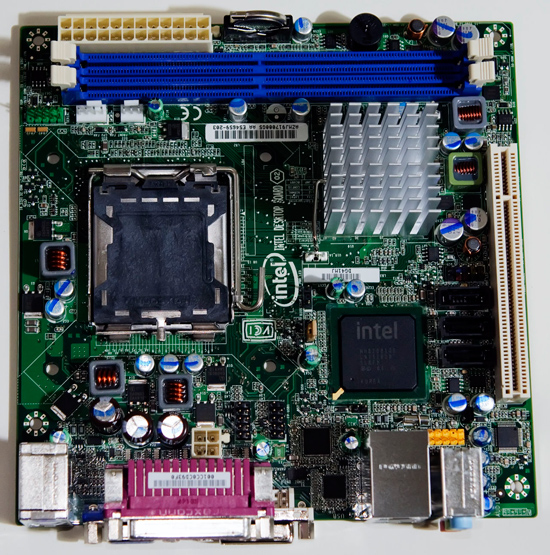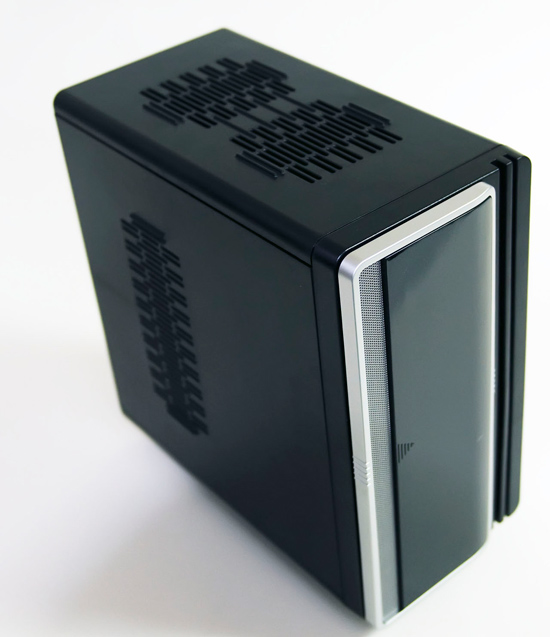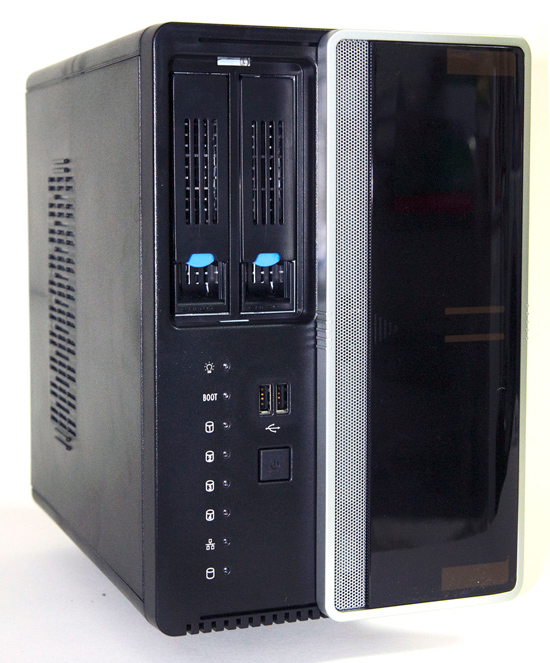Home Servers, Network Storage and the Case House
by Loyd Case on December 2, 2009 12:00 AM EST- Posted in
- Cases/Cooling/PSUs
The X Factor
All we really need around the house is reliable network access, the ReadyNAS would probably run forever – or at least, until it died. But I do like to play with new toys, and I’d been thinking about bringing up a Windows Home Server system for quite a few months.
Of course, you can just buy an off-the-shelf WHS system built by HP or a number of other companies, but that would be too easy. All the PCs in our house were built from the ground up, so I felt compelled to actually build a Windows Home Server system from scratch. Of course, I could have simply taken some of the old PC hardware around here and built up a server from spare parts. That had some attraction, since it would have been fairly inexpensive. It would also have been, in my mind, a somewhat inelegant solution. The smallest power supply I have here is 430W, and even micro ATX cases are bulkier than the ReadyNAS 600.
On the other hand, I’ve had this motherboard for a few months now.

This mini-ITX board is made by Intel, ostensibly for small office or media centric PCs. I never really found a use for it, as most of my applications typically require more graphics horsepower. The Intel DG41MJ board uses the Intel G41 chipset and accepts LGA 775 CPUs (up to 65W TDP.)
Then, one day, I was at my favorite local white box store (Central Computer, in San Jose, CA), and stumbled across this case.

At first, I thought it was just another of many small form factor, slimline cases, ostensibly designed as small Media Center PC cases. But it seemed slightly more bulky than the typical case of that type. The feature list also mentioned “two hot swappable SATA drive bays.” So I slid the front panel open and found that there were, indeed, a pair of hot swappable drive bays.

I checked out the specs and discovered that the Chenbro ES32067 is actually a mini-ITX server case. At roughly $120, it ships with a 150W PSU – smaller than the 220W PSU in the ReadyNAS 600. So I bought one.










87 Comments
View All Comments
shin0bi272 - Thursday, December 10, 2009 - link
that looks pretty sweet. I sort of did something similar when I recently upgraded to an I7 cpu. I took my core2duo guts out of my game box and put them in a oneof case that I modded as a tribute to 9/11 (Im from NY so it hit me pretty hard personally). For years I had nothing to put in the box but considered doing a file server out of it because it was this huge micron tower from the mid 90's (seriously its like 3ft tall wtf?) that used to have a dual p133 mobo in it. I put a raid5 card in it with an enclosure similar to yours only mine holds 5 disks not 2. Im currently running 3x1tb wd ent. drives in it and have 2tb of usable storage with redundancy (and an LTO2 tape drive in another computer that I can back up that server remotely with) and the capability to add another drive.The one thing I am concerned about though will be upgrading to 2 or 4tb drives later but that will be a while Im only half full now.
larsv - Saturday, December 5, 2009 - link
Correction to the article text - the 4-bay Chenbro case ES34069 is same physical size as the case used in the article.To make room for the two extra bays the ES34069 case uses an external PSU. My setup runs an Atom 330 MB, four WD Green drives, and a separate 2.5" boot drive. Power draw at wall socket at idle (drives spun down) is 35W, fully active 46W.
Re WHS: Part of the attraction of WHS, for me, is that my data isn't dependent on specific hardware. If my processor burns to a crisp I can still take each drive and pull the data I need off it using any computer fluent in NTFS. As a contrast, when my ReadyNAS packed up I had to get a new ReadyNAS just to get the data off it. Never will I be that dependent on proprietary hardware again.
Inglix - Sunday, December 6, 2009 - link
I run a very similar build with:200w Chenbro 4 bay case (the "psu" isn't as efficient as I'd like)
Intel DQ45EK mITX (more efficient than the G45 mITX board, and has management tools)
e8400 (cheapest VT wolfdale at the time, an e3200 would do now)
2x2gb 1.8v (I wish these were still $15 after rebate)
60gb Vertex 2k8 r2 boot drive (hey, it was $126 after rebates)
4 WD20EADS pass through for WHS hyper-v
Antec 200mm fan (mounted on the side for extra cooling)
e-sata to sata adapter for the 5th port
I like having a smallish domain server with plenty of space to store WHS & Acronis backups. For cost reasons though I'd still recommend a HP WHS system over a Chenbro build, unless you need alternate OS support.
Zurichtx - Wednesday, December 9, 2009 - link
InglixI like the idea of the SSD drive as an os drive. That extra 2.5 bay in the 4 drive chenbro case it seems like the perfect spot. How has the setup worked out for you? I am considering a simliar rig.
Glaucus - Friday, December 4, 2009 - link
Any word on what the total power consumption is on such a rig? I'm trying to put together a system that will use as little power as possible and looking for ideas.beady - Friday, December 4, 2009 - link
though 2TB isn't the best price point atm, 1.5TB is, or the 2TB greens, but if you manage to fill 4TBs of data you really should look at RAID 5/6 unless you have backups, but not many have backups of backups, but normal failure is only 2%/year or so.but its a good beginner article anyways, not as tech savy as most of anandtech people are but most people don't see the benefits of a nas, its mostly for convenience sake, but setting it up is inconvenient and takes a long time, there are too many options and you have to look all over the web for the different hardware/software configurations and guides almost always from 10-20+ different websites for setting up everything. Simply because there are 100's of different ways to set up home networks for all different things.
here's a link to my HTPC resource;far from complete
http://spreadsheets.google.com/ccc?key=0AtfZAEbM0x...">http://spreadsheets.google.com/ccc?key=...CUVBDejE...
anyways, everyones needs are different, NAS's are generally expensive and not easy to set up and takes awhile regardless of what or how. IMO if you don't have TB's to share then don't bother, its easier to run Tversity on a normal PC or something.
yacoub - Friday, December 4, 2009 - link
At first I thought "The Case House" was some new e-tailer website that specialized in computer cases. Then he started naming family members and I figured it out. ;Pvalnar - Friday, December 4, 2009 - link
So after all that, what is the power consumption?rrinker - Thursday, December 3, 2009 - link
I too built my own, using a low power dual-core Athlon CPU and an integrated video motherboard with 6 SATA ports. I used a small but still ATX case so I'd have enough drive bays, so while my system isn't tiny, it's not a monster, either. It sits under my desk and hums away storing my files, videos, music, and photos, while also backing up my two desktops, one of which runs Win7 64bit. Right now it has 3x 750GB drives (which were the sweet spot in price when I built it - 1TB was 2x the cost for that extra 250GB), and 2x 1TB drives I bought when the prices on those dropped. I don't think my total system cost was as much as this build - AMD has it all over Intel when it comes to low cost low power system - and I have over 4TB of space.WHS is better than most NAS boxes or using RAID for the average home user, it's not overkill. Drobo uses a similar disk data protection scheme - but a Drobo loaded with drives with the ethernet adapter actually cost more thanmy system, and it doesn't do the backup.
As for the HP extras - Twonky is pointless if you stream to a media pc or, in my case, a Popcorn Hour that actually handles pretty much any format you can throw at it. Other media player devices seem very limited especially in terms of what formats they support, requiring an add-on like Twonky or tVersity to convert formats on the fly.
nafhan - Thursday, December 3, 2009 - link
To all the people complaining about prices of build it yourself vs. buying a prebuilt system: remember to be flexible! You can save a lot of money by:1. Reusing parts you already have (like Loyd did).
2. Being flexible on which components you use (you could save $40 - $80 on the case if you don't need hotswappable bays).
3. Waiting for deals, sales come up all time (I bought a 640GB WD drive for $38 a few months ago).
Loyd's price list is a good reference/starting point, but straight retail prices should be viewed as the most you would pay for any of those things. DIY is great for those who are willing to do research to find the best components at the best prices, and not so well for those who aren't.